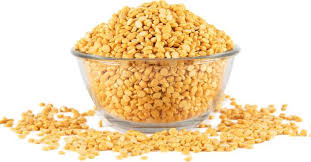Table of Contents
Chana Dal: A Protein-Packed Superfood
Chana Dal, often referred to as Bengal gram or split chickpeas, is a protein-packed superfood that has been a staple in Indian cuisine for centuries. This humble legume not only offers a rich and nutty flavor but also boasts an impressive nutritional profile that makes it a favorite among health-conscious individuals.
In this article, we will delve into the world of Chana Dal, exploring its origins, nutritional benefits, potential health risks, and its versatile culinary uses. Whether you are a fan of Indian cuisine or simply looking to incorporate more plant-based protein into your diet, join us as we uncover the many reasons why Chana Dal deserves its superfood status.
1. Introduction to Chana Dal: The Protein-Packed Superfood
- What is Chana Dal?
Chana Dal, also known as split Bengal gram, is a type of lentil commonly used in Indian cuisine. It is made by removing the outer layer of black chickpeas and splitting them in half. The result is a small, yellow pulse with a nutty and earthy flavor.
- Historical Significance and Cultural Importance
Chana Dal has a rich history and holds a special place in Indian culture. It has been cultivated for centuries and is mentioned in ancient Ayurvedic texts for its health benefits. In Indian households, it is a staple ingredient and often used in a variety of dishes, from comforting dals and curries to crispy snacks.
2. Nutritional Benefits of Chana Dal
- Protein Content and Amino Acid Profile
Chana Dal is a powerhouse of protein, making it an excellent choice for vegetarians and vegans. It is packed with essential amino acids that our bodies need to build and repair tissues. Just a small serving of Chana Dal can provide a significant amount of protein to support muscle growth and overall health.
- Essential Vitamins and Minerals
Aside from protein, Chana Dal is also a great source of essential vitamins and minerals. It is rich in folate, iron, potassium, and magnesium, all of which play crucial roles in maintaining a healthy body. These nutrients contribute to blood formation, nerve function, and muscle contraction, among other functions.
- Dietary Fiber and Digestive Health
Another notable benefit of Chana Dal is its high dietary fiber content. Fiber promotes healthy digestion, prevents constipation, and helps maintain a healthy weight. It also aids in stabilizing blood sugar levels and reducing the risk of developing chronic diseases, such as diabetes and heart disease.
3. Health Benefits and Potential Risks of Consuming Chana Dal
- Sugar Management
Chana Dal has a low glycemic index, which means it doesn't cause a rapid spike in blood sugar levels. This makes it an excellent choice for individuals managing diabetes or those looking to maintain stable blood sugar levels throughout the day.
- Heart Health and Cholesterol Management
The high fiber and potassium content in Chana Dal contribute to heart health. Fiber helps in reducing bad cholesterol levels, while potassium helps regulate blood pressure. By incorporating Chana Dal into your diet, you can work towards a healthier heart and reduce the risk of cardiovascular diseases.
- Weight Management and Satiety
Thanks to its high protein and fiber content, Chana Dal can help you feel full and satisfied for longer periods. This can assist in controlling cravings and managing weight. Including Chana Dal in your meals can be a smart strategy for those aiming to shed a few pounds or maintain a healthy weight.
- Allergies and Potential Risks
While Chana Dal is generally safe for consumption, individuals with allergies to legumes should exercise caution. It's advisable to consult with a healthcare professional if you have any known allergies or concerns regarding Chana Dal consumption.
4. Culinary Uses and Popular Chana Dal Recipes
- Traditional Indian Dishes
Chana Dal is a key ingredient in a variety of traditional Indian dishes. From the classic Chana Dal curry to mouthwatering snacks like Chana Dal vada or Chana Dal chaat, this versatile pulse adds a unique texture and flavor to Indian cuisine.
- Chana Dal in Soups and Stews
The earthy taste and hearty texture of Chana Dal make it a perfect addition to soups and stews. Whether you're whipping up a comforting lentil soup or a robust vegetable stew, Chana Dal can bring depth and substance to your culinary creations.
- Chana Dal Snacks and Appetizers
Chana Dal is also a star ingredient in many crunchy snacks and appetizers. From crispy roasted Chana Dal to spicy Chana Dal namkeen, these savory treats offer a tasty and nutritious option for snacking between meals or entertaining guests.
So, whether you want to amp up your protein intake, boost your fiber intake, or simply experiment with new flavors, Chana Dal is a superfood that offers a wide range of health benefits and culinary possibilities. Give it a try and let your taste buds rejoice!
5. How to Cook Chana Dal: Preparation and Cooking Methods
- Soaking and Washing Chana Dal
Before cooking chana dal, it's important to give it a good soak. This helps to soften the dal and reduces the cooking time. Rinse the chana dal under running water to get rid of any dirt or debris. Then, place it in a bowl and cover it with water. Let it soak for at least 2 hours or overnight if you have the time. Once soaked, drain the water and your chana dal is ready to be cooked!
- Stovetop Cooking Instructions
Cooking chana dal on the stovetop is a straightforward process. Start by adding the soaked and drained chana dal to a pot, along with enough water to cover it. Bring the water to a boil, then reduce the heat and let it simmer for about 30-40 minutes, or until the dal is tender. Make sure to stir occasionally and add more water if needed. Once the dal is cooked, you can season it with your preferred spices and enjoy!
- Pressure Cooker and Instant Pot Methods
If you're short on time, using a pressure cooker or an Instant Pot can be a game-changer. After soaking and rinsing the chana dal, simply add it to the pressure cooker or Instant Pot with enough water to cover it. For a pressure cooker, cook on high pressure for about 8-10 minutes, and then let the pressure release naturally. For an Instant Pot, use the manual or pressure cook function for about 8-10 minutes, followed by a quick pressure release. And voila! Your chana dal is ready to be devoured.
6. Chana Dal in Different Cuisines: Exploring its Global Appeal
- Chana Dal in South Asian Cuisine
Chana dal is a staple in South Asian cuisine, where it is used in a variety of dishes. From classic curries like chana masala to mouth-watering snacks like chana dal pakoras, it adds a nutty flavor and creamy texture to these dishes. Whether you're savoring it with rice, roti, or naan, chana dal brings a delightful element to South Asian cooking.
- Chana Dal in Middle Eastern Cuisine
Chana dal also has a prominent place in Middle Eastern cuisine, particularly in dishes like falafel. It is often ground into fine flour and combined with other ingredients to make these crispy and flavorful chickpea patties. Additionally, chana dal is a key component in the popular Lebanese dish called mujadara, where it is cooked with rice, lentils, and aromatic spices for a wholesome and satisfying meal.
- Chana Dal in African Cuisine
Chana dal has made its way into various African cuisines, adding its unique taste and nutritional benefits. In countries like Ethiopia and Sudan, chana dal is often used in stews, soups, and even in traditional bread recipes. It brings a rich and hearty element to these dishes, making them even more delicious and satisfying.
7. Chana Dal as a Sustainable Food Source: Environmental Impact and Farming Practices
- Environmental Benefits of Chana Dal Cultivation
Besides being a tasty addition to our meals, chana dal has some impressive environmental benefits too. As a legume, chana dal has the remarkable ability to remove nitrogen from the atmosphere and enrich the soil with this essential nutrient. This reduces the need for synthetic fertilizers, making chana dal cultivation more sustainable and environmentally friendly. Additionally, the deep taproots of the chana plant help improve soil structure, prevent erosion, and conserve water.
- Organic and Sustainable Farming Practices
Many farmers embrace organic and sustainable farming practices when cultivating chana dal. These include avoiding the use of chemical pesticides and fertilizers, opting for natural methods of pest control, and promoting biodiversity on their farms. By choosing organic and sustainably grown chana dal, we support farmers who prioritize the health of the soil, the environment, and our well-being.
So go ahead, embrace the protein-packed goodness of chana dal in your cooking, celebrate its global appeal, and feel good knowing that you're enjoying a sustainable and environmentally friendly food source.
In conclusion, Chana Dal truly lives up to its reputation as a protein-packed superfood. With its abundance of essential nutrients, versatility in cooking, and potential health benefits, incorporating Chana Dal into your diet can be a delicious and nutritious choice.
Whether you enjoy it in traditional Indian dishes, explore its global culinary appeal, or embrace it as a sustainable food source, Chana Dal is sure to bring both flavor and nourishment to your meals. So, next time you're looking for a wholesome and protein-rich ingredient, remember to give Chana Dal a try and experience the wonders of this superfood firsthand.
FAQ
1. Is Chana Dal gluten-free?
Chana Dal is naturally gluten-free, making it a suitable choice for individuals with gluten intolerance or celiac disease. However, it is important to ensure that the Chana Dal is not processed in facilities that also handle gluten-containing grains to avoid cross-contamination.
2. Can Chana Dal be consumed raw?
No, Chana Dal should not be consumed raw. Raw Chana Dal is hard and difficult to digest. It is important to soak and cook Chana Dal thoroughly before consuming it to enhance its taste, texture, and digestibility.
3. Can Chana Dal be substituted for other legumes?
Yes, Chana Dal can be a versatile substitution for other legumes in various recipes. It can replace other split lentils or beans in soups, stews, curries, or even in baking recipes. However, keep in mind that the cooking time and texture may vary, so adjustments might be needed when substituting Chana Dal for other legumes.
4. Are there any potential allergic reactions to Chana Dal?
While Chana Dal is generally safe for consumption, some individuals may experience allergic reactions, especially if they have a history of legume allergies. Symptoms such as itching, swelling, or difficulty breathing may occur. If you have any concerns or known allergies, it is recommended to consult with a healthcare professional before adding Chana Dal to your diet.




